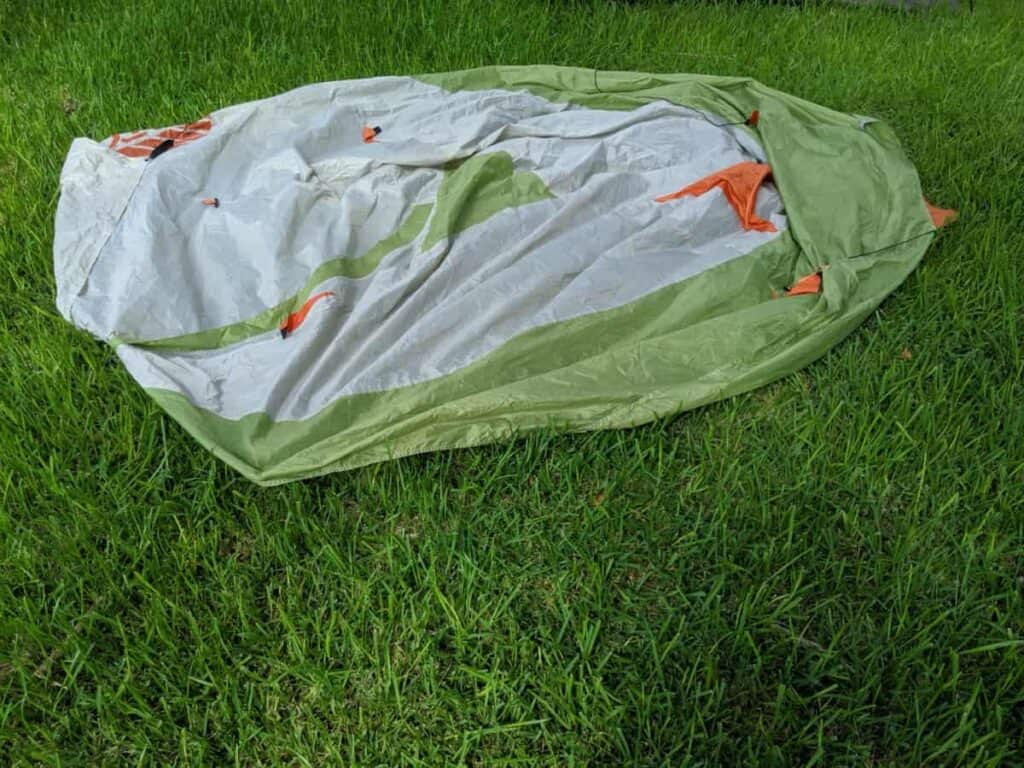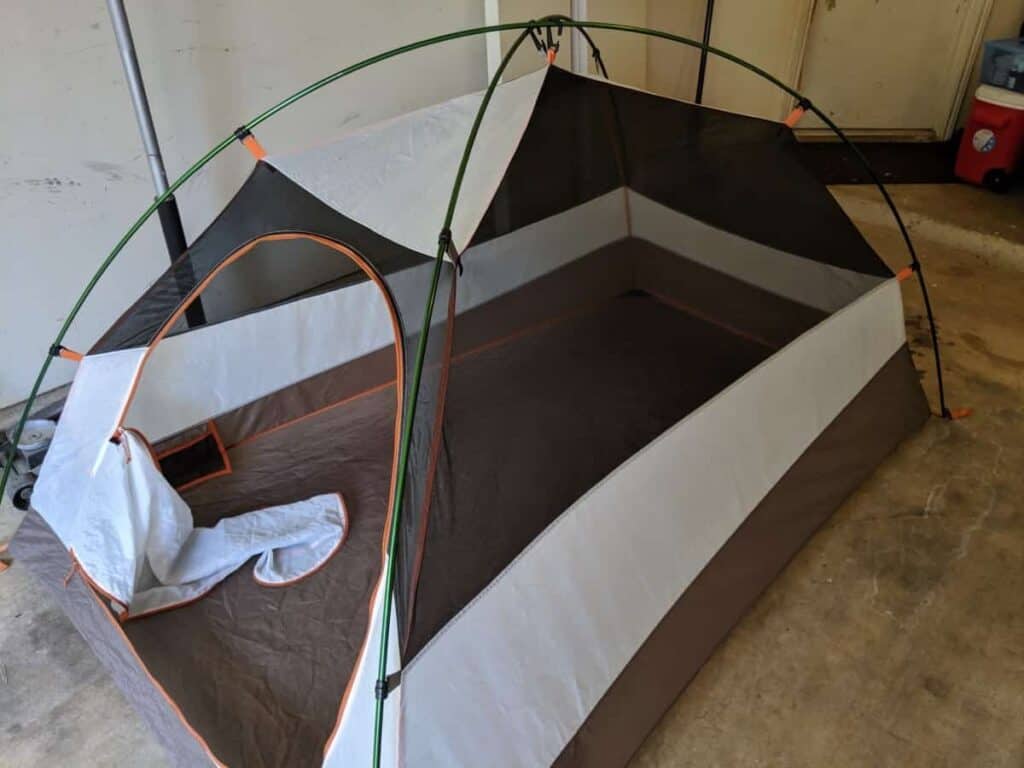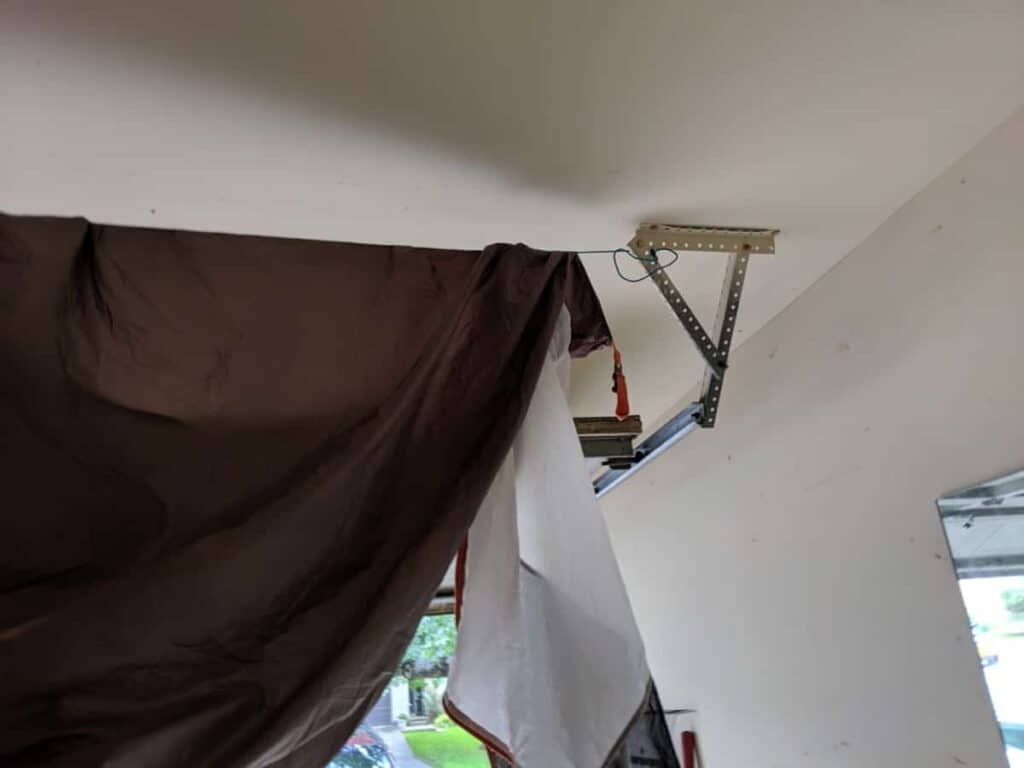Rain is beautiful, but not in your tent. I’ll show you how to dry your tent even if you don’t have a place to set it up in or out of your house.
Packing a wet tent encourages mildew, which, if unchecked, can damage the fabric of your tent and shorten its useful lifespan.
You can dry your tent by setting it up outside your house, or inside with fans. Depending on your tent size you might have to use a clothesline instead of setting it up, or, lastly, hanging your tent in your shower can work if you provide enough ventilation.
By the way, as an Amazon Associate, I earn when buying qualified products through links on my site.
Drying Method 1: Setting Up Your Tent Outside Your Dwelling

Setting up your tent (again) when you get home before you store your tent is the most effective method for drying your tent for mold control. Important also is to make sure you set up your tent in a location in direct sunlight and somewhere a breeze can get to. In the backyard in the shadow of your big oak tree may not dry as quickly as you’re hoping.
Step 1: Set up your tent without the rain fly as you would when you’re camping.
Step 2: Lay out your rain fly and ground cloth spread out–ideally in a location with sun and that’s not going to pick up grass or other stray materials (your driveway works well here).
Step 3: Make sure to flip your rain fly and ground cloth after the sun-facing side is dry.

Depending on the weather, this could take just a few hours to dry your tent.
Direct sunlight’s UV rays kill mold spores, and will also speed the drying process. Airflow from the wind will ensure all the nooks of your tent will get dry as well.
Remember to not leave your tent set up like this after your tent is dry! The sun will damage your synthetic tent much faster than mold will. Canvas tents can take a bit more of a beating from the sun, but they too should not be left long in direct sunlight–so it’s much better to protect your tent from the sun after the drying is done.
Reasons Why Setting Up Your Tent Outside Might Not Work
Reason 1: Weather
The most obvious reason why setting up your tent outside might not work is if it’s raining or if it’s overcast and cold. You might have gotten home from a freezing cold and wet camping trip, so setting up your tent in the cold outside will do little to dry it out. A cold dry wind can still do the trick, however (it sure does the trick on your lips).
Reason 2: Adequate Room and Environment
You might not have room to set up your tent outside. If you live in a condo or an apartment, you actually might not have space to put up your tent. Furthermore, even if you technically have the real estate, your cars might be parked in the driveway, and you have a xeriscaped lawn where you might not have any non-cactus area that would work well for a tent.
Reason 3: You Just Finished Camping and You’re Tired
This reason undoubtedly applies to any tent-drying method. But it’s especially applicable to this solution. Some tents are quite easy to set up, and others are more complicated. If you’ve had a long camping trip, especially a backpacking trip or a long hike, the last thing you feel like doing is setting up your tent, again.
Drying Method 2: Setting Up Your Tent Indoors

Setting up your tent indoors is another way to dry your tent. The great indoors has some restrictions though that may warrant additional attention.
Since most indoor locations do not have direct sunlight (unless you are lucky enough to have a Florida/Arizona/lots-of-sunlight room), then you have to take matters into your own hands to ensure the drying process will continue.
Using a standing or box fan makes this process much more easier. Set up the fan to blow in one side of the tent and out the other. Creating continuous airflow will make sure your tent dries in no time.
Make sure and turn on the ceiling fan, if you have one.
If it’s not humid outside, crack some windows to get as much air through the room with your tent as possible. If it’s humid inside, this might lengthen your drying process.
If you don’t have enough room in your house, but if you are like 75% of Americans who can park in their garage, then the garage is another location where you can set up your tent to dry.

Step 1: Set up your tent indoors as you would while you’re camping without the rain fly attached.
Step 2: Dry your tent as best as you can with a towel. Remember, mold can start growing on a tent within 24-48 hours. It’s best to speed up the drying process as much as possible, especially if you had to wash dirt and mud off of your tent when you got home.
Step 2: Set up airflow by placing fans blowing into the tent and turn on any ceiling fans, and crack any windows (humidity permitting)
Step 3: When the tent is dry, you can clip on the rain fly and continue the exercise. Stretching out the rain-fly as much as possible ensures that no creases will hide water
Reasons Why Setting Up Your Tent Indoors Might Not Work
Reason 1: Not Enough Room
Even if you might, technically, have space to set up your tent inside, if you aren’t able to walk through your house, this might not be a viable option.
Reason 2: You Don’t Want to Get Your House Wet
Depending on how wet your tent is, then setting it up inside might cause a big mess. Furthermore, when a tent gets wet outside it tends to get muddy. Therefore you don’t want to move the mold and muddy problem from your tent to your house.
If your tent is muddy, then a good option is to rinse it out in a bucket or a tub. This is a great way to get all foreign objects off your tent. In fact, having a dirty tent might be the reason mildew is getting on your synthetic tent in the first place! Removing food for mold is a great way to prevent mold from growing.
Drying Method 3: Hanging Up Your Tent on a Makeshift Clothesline
The term makeshift clothesline can take many forms here.
- Draping some para-cord across your living room or garage
- Using hooks in the ceiling or shelves to anchor edges of the tent
- Using chairs or stools to suspend the tent above the ground
- Using an actual clothesline (I suppose it’s not makeshift anymore at that point)
- Using your apartment balcony railing (better wipe it down first, those get gross)
- Using a tree branch if you have one nearby (careful not to rub the tent fabric, especially the mesh against the bark of the tree)

To make this less messy, if you are doing this indoors, you can use towels and newspaper to catch any drips coming from the tent. You can accelerate the drying by using those towels to dry off the tent as much as possible before letting it hang to dry.
As we learned in other methods, use fans to get as much airflow as you can throughout the room if your clothesline is inside.
The steps for this method will vary depending on what type of clothesline you are trying to tie or create.
If you’re tying a clothesline, for knots, I recommend a bowline or other fixed loop on one side of the line and then wrapping it around a stationary object and feeding the line through that loop. After that, you can use a taut-line hitch to tighten your clothesline adequately to support the weight of your tent.

For ceiling hooks, you are very likely to find places to secure your tent on the ceiling within your garage. Make sure to not tie anything to the track that opens your garage door (if your garage has a track garage door). But, there should be suspension brackets to support your garage door. These are great anchors to tie up a clothesline or just tie your tent directly to.
Reasons Why Creating a Makeshift Clothesline May Not Work
Reason 1: Time-consuming
In this method you are only limited by your time-constraints (or motivation). It can take time to set up some sort of system to hang up your tent… (or it can be as simple as moving some stools around).
Drying Method 4: Hanging Up Your Tent in the Shower
Depending on the size of your tent, it’s possible to hang up your tent in the shower, although you might have to get creative to get to all the crevices in the tent.
Remember, you get priority for access to the shower after a camping trip, not your camping equipment. 🙂
Step 1: Keep the shower curtain/door open, as well as the door to the bathroom. (you want as much airflow as possible in a confined space).
Step 2: You can use a space heater to dry out the air in the bathroom and warm up the room to encourage evaporation. Make sure to not direct the space heater towards the tent itself to prevent fabric warping/shrinking.
Step 3: Drape the tent over the curtain rod and spread out the fabric as much as possible. If there are window ledges or shower hooks, you can use these to stretch out the fabric.
Step 4: Position fans to try and get as much airflow as possible in and around the tent to dry it off.
Step 5: When the tent is dry, position the rain fly and ground cloth in the same way as space allows.
Reasons Why Hanging Your Tent in Your Shower Might Not Work
Reason 1: Your Tent is Too Big
If you have a 2-person tent, this method is much more doable. If, however, you have a 10-person tent, then your shower is not going to be big enough. To make this work, you’ll have to continuously rotate the tent folds to ensure you get every spot dry. This is even necessary with a 2-man tent. With a 10-man tent, this is difficult to do, and it’s easy to miss a crease or two.
Reason 2: The Shower Line is Long
In all seriousness, if you and your spouse have work tomorrow, and your kids have to go to school, then tying up the shower with a tent may not be feasible. This could work on the weekend where showering is not so urgent (come on… we all know you haven’t showered on some Saturdays).
Drying Methods to Avoid:
- Clothes Dryer: The clothes dryer rotates fabric around with plastic blades and applies heat to dry. The heat can warp and ruin the tent fabric (and shrink cotton canvas tents), and the tumbling action can stretch or stress tent fabric in ways it was not intended. This may work in the short-term but will shorten the lifespan of your tent. You could mitigate the damage by using a delicates clothes bag such as can be found here (see price on Amazon). But again, this is not a recommended drying method.
- Hair Dryer: Hair Dryers apply hot air to wet hair (what’s with that glare?). Hot air from a hair dryer will have the same effect as a clothes dryer, and will warp and stretch synthetic materials, and may cause shrinking for cotton canvas tents. If you put the hair dryer on cold air, that will work, but at that point you might as well get a box fan (see price on Amazon).
- Allowing the tent to dry in its carrying bag: The tent can retain moisture for weeks with this method, which gives plenty of time for mold to grow.
Drying Canvas Tents
Everything I’ve said about the importance of drying your tent should be magnified 10x when talking about canvas tents. Because canvas tents often have organic fibers, they are more susceptible to becoming damaged from mold. In fact, mold can destroy a canvas tent.
The best protection is prevention, and that means ensuring your tent is completely dry before packing. If this isn’t an option (such as if you are leaving camp in the rain), then you must perform all the drying methods in the book to ensure that your canvas tent is dry before you store it.
Heat can warp synthetic tent material, but it can also cause fabric to pull and stretch in unexpected ways, so make sure to not apply direct heat to your fabric tent.
What Happens If I’m Too Late And There Is Mold In My Tent?
It’s not the end of the world if your tent gets a little mildewy/moldy. Mold can be removed in many cases. Check out our article for strategies to clean your tent as well as learn what might happen if your tent gets moldy.
Is Drying Your Tent a Big Deal?
Even if your tent has a only little moisture on it when you pack it up, fungi called mildew can start growing on your tent.
What is Mildew?
Mildew is a type of fungus, and can be considered a type of mold. It’s main characteristic that’s relevant here is that it tends to grow on moist flat surfaces, such as a the walls and floors of a tent. Mildew is powdery and white or grayish in appearance.
You’ve definitely encountered mildew before by its smell. If you’ve ever left your laundry in the wash for a day or two, you probably remember the unpleasant smell that forced you to run your clothes through the wash, again.
What Happens If Mildew Persists?
Mildew can eventually penetrate into the fibers and actually and compromise the fabric of the tent. (source regarding mildew and fabric) This is especially true of any tents with organic fabrics such as canvas tents which use at least some percentage of cotton.
Besides harming the tent, mildew can trigger allergic reactions in people. If your tent smells funky, then it’s time to take action and to clean your tent to get rid of any mold.
How Long Does it Take for Mildew to Grow?
Mildew growth depends on a number of factor, including the exact type of fungi spore, the relative humidity, temperature, and the type of fabric.
Depending on conditions, a surface can accumulate mold within 24-48 hours of becoming damp. (source).
How Can I Prevent Mildew or Mold Growth?
The key to preventing mold is by making sure your tents are completely dry when you store them. This is even important for synthetic tent materials such as nylon, polyester, silnylon, etc., because even though mold doesn’t feed directly on synthetic materials, it can feed on the dirt, and other food sources such as sweat and other substances that you might not be able to see.
Keeping your tent clean and dry is not just being nice to your personal belongings, it’s essential to make your tent last as long as possible. This is even more important for canvas tents!
Additionally, mold of all types hate sunlight. They’re like trolls in that way. The problem is that most fabrics don’t really like direct sunlight either. So you have to make sure and only use the sun to control mold for short periods of time.
Bottom-Line
Drying your tent is essential to keeping your tent healthy. It’s important for synthetic tents, and many times more important for canvas tents. Not only that, your own health is improved by not exposing yourself to any mold growth. Let’s learn how to dry your tent!
Summary
Drying a tent can be arduous! Don’t let this stop you, though. It’s important for the longevity of your tent, preventing mildew and subsequent fabric damage and even health concerns. I admit, I’ve put away a tent that was wet before–after doing this research, though, I want to do better and take care of my camping equipment so it can keep us into adventure as long as possible.

